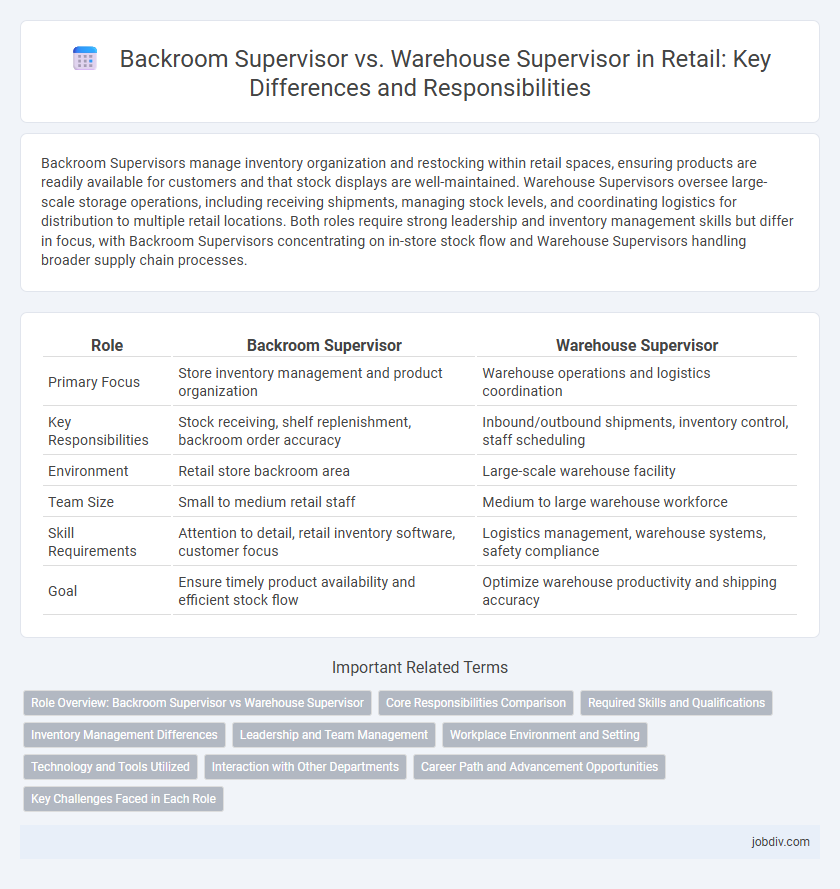Backroom Supervisors manage inventory organization and restocking within retail spaces, ensuring products are readily available for customers and that stock displays are well-maintained. Warehouse Supervisors oversee large-scale storage operations, including receiving shipments, managing stock levels, and coordinating logistics for distribution to multiple retail locations. Both roles require strong leadership and inventory management skills but differ in focus, with Backroom Supervisors concentrating on in-store stock flow and Warehouse Supervisors handling broader supply chain processes.
Table of Comparison
| Role | Backroom Supervisor | Warehouse Supervisor |
|---|---|---|
| Primary Focus | Store inventory management and product organization | Warehouse operations and logistics coordination |
| Key Responsibilities | Stock receiving, shelf replenishment, backroom order accuracy | Inbound/outbound shipments, inventory control, staff scheduling |
| Environment | Retail store backroom area | Large-scale warehouse facility |
| Team Size | Small to medium retail staff | Medium to large warehouse workforce |
| Skill Requirements | Attention to detail, retail inventory software, customer focus | Logistics management, warehouse systems, safety compliance |
| Goal | Ensure timely product availability and efficient stock flow | Optimize warehouse productivity and shipping accuracy |
Role Overview: Backroom Supervisor vs Warehouse Supervisor
Backroom Supervisors oversee inventory management and stock organization within the retail store's backroom, ensuring timely replenishment of sales floors and maintaining accurate stock records. Warehouse Supervisors manage the broader logistics operations, including receiving shipments, overseeing storage systems, and coordinating outbound deliveries to multiple retail locations. Both roles require leadership in inventory control but differ in scope, with Backroom Supervisors focusing on in-store stock flow and Warehouse Supervisors handling larger-scale warehouse logistics.
Core Responsibilities Comparison
Backroom Supervisors manage in-store inventory, ensuring accurate stock levels, organizing product displays, and coordinating with sales staff to replenish shelves efficiently. Warehouse Supervisors oversee large-scale storage operations, focusing on receiving, storing, and shipping goods, maintaining safety protocols, and optimizing warehouse logistics. Both roles require strong leadership and inventory management skills but differ in scope, with Backroom Supervisors emphasizing retail floor support and Warehouse Supervisors concentrating on supply chain and distribution processes.
Required Skills and Qualifications
Backroom Supervisors require strong inventory management skills, proficiency in point-of-sale systems, and experience in coordinating retail stock replenishment to ensure seamless store operations. Warehouse Supervisors need expertise in logistics, forklift operation certification, and knowledge of safety regulations to efficiently manage warehouse personnel and optimize storage processes. Both roles demand leadership abilities, attention to detail, and effective communication to maintain workflow and meet organizational targets.
Inventory Management Differences
Backroom Supervisors prioritize managing inventory flow within retail stores, ensuring stock is properly organized, replenished, and ready for sales floors to minimize out-of-stock situations. Warehouse Supervisors focus on overseeing larger-scale inventory storage, coordinating inbound and outbound shipments, and maintaining accurate warehouse records for bulk inventory management. The key difference lies in the scale and scope of inventory responsibility, with Backroom Supervisors handling in-store stock accuracy and Warehouse Supervisors managing extensive inventory logistics.
Leadership and Team Management
Backroom Supervisors specialize in coordinating in-store inventory processes and leading teams to efficiently manage stock replenishment and order preparation. Warehouse Supervisors oversee larger-scale storage operations, directing forklift operators and warehouse staff to optimize space utilization and ensure timely shipment fulfillment. Both roles require strong leadership skills, but Backroom Supervisors focus more on retail floor support while Warehouse Supervisors emphasize logistical coordination and warehouse safety compliance.
Workplace Environment and Setting
Backroom Supervisors manage inventory and staff within the retail store's back area, ensuring smooth stock replenishment and organization in a fast-paced, customer-facing environment. Warehouse Supervisors oversee larger-scale storage facilities, coordinating inbound and outbound logistics, often in more industrial settings with heavy machinery and extensive shelving systems. The workplace environment for Backroom Supervisors is typically more compact and integrated with the retail floor, while Warehouse Supervisors operate in expansive, controlled warehouses with a focus on bulk inventory and distribution efficiency.
Technology and Tools Utilized
Backroom Supervisors typically use inventory management systems and handheld scanning devices to monitor stock levels and ensure accurate product placement, integrating point-of-sale data for real-time updates. Warehouse Supervisors manage more advanced technology such as automated conveyor belts, inventory management software with AI capabilities, and forklift tracking systems to optimize large-scale distribution and shipping processes. Both roles leverage RFID technology and warehouse management systems (WMS), but Warehouse Supervisors handle higher volumes and complex logistics tools.
Interaction with Other Departments
A Backroom Supervisor collaborates closely with sales and merchandising teams to ensure stock accuracy and timely replenishment on the retail floor, facilitating smooth customer experiences. In contrast, a Warehouse Supervisor coordinates primarily with logistics, procurement, and inventory control departments to optimize storage operations and distribution efficiency. Effective interaction between these supervisors and other departments enhances inventory flow and supports overall retail performance.
Career Path and Advancement Opportunities
Backroom Supervisors typically oversee inventory organization and stock replenishment within retail stores, offering a clear pathway to roles such as Inventory Manager or Store Operations Manager through experience in store logistics. Warehouse Supervisors manage broader supply chain operations, including receiving, storage, and distribution, providing advancement opportunities toward Supply Chain Manager or Logistics Director positions due to their extensive operational oversight. Both roles demand strong leadership and organizational skills, but Warehouse Supervisors often have greater potential for upward mobility in large-scale distribution networks.
Key Challenges Faced in Each Role
Backroom Supervisors tackle challenges such as managing limited space efficiently, ensuring accurate inventory replenishment, and maintaining seamless communication between sales floor and storage areas. Warehouse Supervisors face complexities involving large-scale inventory management, coordinating logistics for timely shipments, and ensuring workplace safety compliance within expansive warehouse environments. Both roles demand strategic problem-solving but differ in scope, with Backroom Supervisors focusing on immediate retail support and Warehouse Supervisors handling broader supply chain operations.
Backroom Supervisor vs Warehouse Supervisor Infographic

 jobdiv.com
jobdiv.com